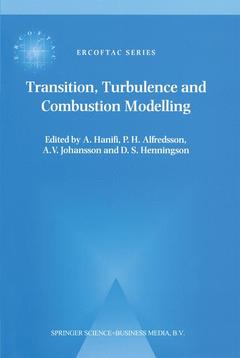Description
Transition, Turbulence and Combustion Modelling, 1999
Lecture Notes from the 2nd ERCOFTAC Summerschool held in Stockholm, 10–16 June, 1998
ERCOFTAC Series, Vol. 6
Language: English
Keywords
aerodynamics; combustion; fields; flow; laminar flow; simulation; stability; turbulence; turbulent flow
Publication date: 10-2012
532 p. · 16x24 cm · Paperback
532 p. · 16x24 cm · Paperback
Description
/li>Contents
/li>
The aim of the present book is to give, in a single volume, an introduction to the fields of transition, turbulence and combustion modelling of compressible flows and to provide the physical background for today's modelling approaches in these fields. The basic equations for compressible flows are presented (Ch. 1). The fundamental aspects of hydrodynamical instability are discussed (Ch. 2). along with transition prediction methods in industrial applications (Ch. 3). Turbulence modelling approaches ranging from single-point models (Ch. 4, 5) to large-eddy simulation techniques (Ch. 6), direct numerical simulations (Ch. 7) and turbulence combustion modelling (Ch. 8) are covered. The book addresses engineers and researchers, in industry or academia, who are entering into the fields of transition, turbulence or combustion modelling research or who need to apply turbulence or transition prediction methods in their work.
1 Introduction.- 1.1 Equations for compressible flows.- 1.2 Laminar boundary layers.- 1.3 Combustion.- References.- 2 Stability of Boundary Layer Flows.- 2.1 Introduction.- 2.2 Introduction to stability of incompressible parallel flows.- 2.3 Stability of compressible parallel flows.- 2.4 Stability of non-parallel compressible flows.- 2.5 Applications.- References.- 3 Transition Prediction in Industrial Applications.- 3.1 Introduction.- 3.2 Qualitative description of some transition mechanisms.- 3.3 Some theoretical elements for “natural” transition.- 3.4 The eN method.- 3.5 Application to transonic flows : laminar flow control.- 3.6 Application to high speed flows.- 3.7 Conclusion.- References.- 4 An Introduction to Turbulence Modelling.- 4.1 Introduction.- 4.2 Basic properties of turbulence and the mean flow equation.- 4.3 Transport equations for single-point moments.- 4.4 The hierarchy and history of single-point closures.- 4.5 What should a closure fulfill?.- 4.6 Purely algebraic models.- 4.7 Eddy-viscosity based two-equation models.- 4.8 Differential Reynolds stress models for incompressible flow.- 4.9 Algebraic Reynolds stress models.- References.- 5 Modelling of Turbulence in Compressible Flows.- 5.1 Introduction.- 5.2 Averaged equations.- 5.3 Compressibility effects due to turbulent fluctuations and modelling of explicit compressibility terms.- 5.4 Transport equation models.- References.- 6 Large-Eddy Simulations of Incompressible and Compressible Turbulence.- 6.1 Introduction.- 6.2 Large-eddy simulation (LES) formalism.- 6.3 Smagorinsky’s model.- 6.4 Spectral Eddy-viscosity and eddy-diffusivity models.- 6.5 Return to physical space.- 6.6 Vortex control in a round jet.- 6.7 Rotating flows.- 6.8 Compressible LES formalism.- 6.9 Compressible mixing layer.-6.10 Compressible boundary layers on a flat plate.- 6.11 Conclusion.- References.- 7 Direct Numerical Simulations of Compressible Turbulent Flows: Fundamentals and Applications.- 7.1 Introduction.- 7.2 Physical nature of compressible turbulent flows.- 7.3 Governing equations.- 7.4 Numerical methods.- 7.5 DNS of compressible free-shear flows.- 7.6 DNS of shock-turbulence interaction.- 7.7 DNS of aerodynamically-generated sound.- 7.8 Concluding remarks.- References.- 8 Turbulent Combustion Modelling.- 8.1 Introduction.- 8.2 Mixture fraction based theories.- 8.3 Large-eddy simulations.- References.
© 2024 LAVOISIER S.A.S.




